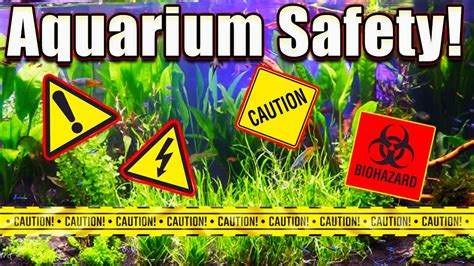Aquariums provide a captivating glimpse into the underwater world, offering tranquility and beauty to homes and businesses alike. However, maintaining an aquarium requires careful attention to safety and precautions to ensure the well-being of both its aquatic inhabitants and those who care for them.

Hazards to Consider
Before delving into the precautions, it is crucial to recognize the potential hazards associated with aquariums:
- Electrical Hazards: Electrical equipment used for filtration, lighting, and heating can pose a significant risk if not properly installed and maintained. Ensure proper grounding and insulation to prevent electrical shocks and fires.
- Waterborne Hazards: Water in aquariums can harbor harmful bacteria and parasites that can transmit diseases to humans and animals. Handwashing and regular water changes are essential for minimizing these risks.
- Animal Hazards: Fish and aquatic creatures can transmit zoonotic diseases through bites or scratches. Always handle animals with care and seek medical attention promptly if any injuries occur.
- Chemical Hazards: Cleaning chemicals, fertilizers, and water treatments contain potentially harmful substances. Store and handle these products safely to prevent contamination or exposure.
- Structural Hazards: Glass tanks can shatter inadvertently, causing injury or damage. Secure and maintain tanks properly to prevent such accidents.
Precautionary Measures
To mitigate these hazards and ensure aquarium safety, a comprehensive approach to precautions is essential:
- Electrical Safety: Use certified electrical equipment, follow manufacturer’s instructions, and inspect wiring regularly for damage or wear.
- Water Hygiene: Perform regular water changes to remove waste and prevent ammonia spikes. Use a water testing kit to monitor water quality parameters and adjust as needed.
- Animal Care: Quarantine new animals before introducing them to the aquarium to prevent disease transmission. Provide adequate food, shelter, and filtration to maintain animal health.
- Chemical Handling: Store cleaning chemicals and other aquarium products in a safe location away from children and pets. Wear gloves and follow instructions carefully when using these products.
- Tank Maintenance: Clean tanks regularly to remove debris and algae. Inspect seals and seams for any leaks or damage.
Case Study: Aquarium Electrical Safety
In 2019, a faulty electrical outlet caused an aquarium fire in a family home, resulting in significant property damage and injuries to two individuals. This incident highlights the importance of proper electrical safety measures, including:
- Using ground fault circuit interrupters (GFCIs) to prevent electrical shocks
- Inspecting electrical cords and plugs for damage or wear
- Avoiding overloading electrical outlets
Tips and Tricks
- Use a drip loop: Create a downward loop in the electrical cord where it enters the outlet to prevent water from dripping down and causing a short circuit.
- Secure electrical cords: Use cable ties or clips to keep electrical cords away from water and potential tripping hazards.
- Install a surge protector: A surge protector can protect electrical equipment from voltage spikes and power outages.
- Label chemicals clearly: Store and label cleaning chemicals and other aquarium products in a separate area to avoid confusion or accidental ingestion.
- Keep an emergency kit: Have a first aid kit and spill kit readily available in case of any accidents or emergencies.
Frequently Asked Questions
Q: How often should I change the water in my aquarium?
A: Water changes should be performed regularly, typically once or twice per week, to remove waste and maintain water quality.
Q: What is the best way to clean an aquarium filter?
A: Rinse the filter media gently in aquarium water to remove debris without damaging the beneficial bacteria. Do not use tap water, as it can kill the bacteria.
Q: How can I prevent electrical shocks from my aquarium?
A: Use GFCIs, inspect electrical cords, avoid overloading outlets, and keep water away from electrical components.
Q: What are the signs of a sick fish?
A: Signs of a sick fish can include lethargy, loss of appetite, clamped fins, and changes in appearance or behavior. Seek immediate veterinary care if you suspect your fish is unwell.
Market Insights
The aquarium market is projected to reach $18.3 billion by 2025, driven by growing consumer interest in home aquariums and the increasing popularity of aquatic pets. Key trends shaping the market include:
- Smart Aquarium Technology: Advancements in technology have led to the development of smart aquariums that monitor water quality, dispense food, and control lighting remotely.
- Sustainability: Consumers are increasingly seeking sustainable aquarium products and practices, such as energy-efficient lighting and biodegradable filter media.
- Personalized Aquariums: The market is witnessing a demand for customized aquariums that cater to specific design preferences and animal needs.
Conclusion
Aquariums offer a myriad of benefits, including stress relief, educational opportunities, and a connection to nature. By implementing comprehensive safety and precautionary measures, aquarium owners can ensure the well-being of their aquatic inhabitants and create a safe and enjoyable environment for all. Remember, a little foresight and diligence can go a long way in preventing accidents and preserving the beauty and tranquility of your aquarium for years to come.





















